Art Work of the Parisada Hindu Dharma Indonesi or Bali Rubenstein
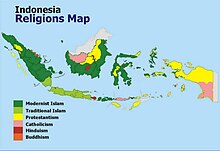
Religion map in Indonesia with Hinduism shown in ruby.
Hinduism in Indonesia, every bit of the 2018 census, is practised past about 1.74% of the total population, and well-nigh 87% of the population in Bali.[1] Hinduism is one of the half dozen official religions of Republic of indonesia.[2] Hinduism came to Indonesia in the 1st-century through traders, sailors, scholars and priests.[3] A syncretic fusion of pre-existing Javanese folk religion, culture and Hindu ideas, that from the sixth-century as well synthesized Buddhist ideas as well, evolved as the Indonesian version of Hinduism.[4] These ideas connected to develop during the Srivijaya and Majapahit empires.[5] About 1400 CE, these kingdoms were introduced to Islam from coast-based Muslim traders, and thereafter Hinduism mostly vanished from many of the islands of Indonesia.[6] [vii]
In 2010, the Ministry of Religious Affairs of the Government of Indonesia estimated that about 10 million Hindus lived on Indonesian islands,[8] in contrast to the 2010 Indonesian official decadal census of over 4 one thousand thousand.[1] [9] Indonesia has the 4th-largest population of Hindus in the world, subsequently India, Nepal and Bangladesh.[ten] The Parisada Hindu Dharma Indonesia disputed the decadal census methodology, and estimated 18 million Hindus lived in Indonesia in 2005.[11] [12] Though being a minority faith, the Hindu culture has influenced the style of life and day-to-day activities in Indonesia.[13] Outside of Bali, many adherents of traditional indigenous religions identify as Hindus in gild to gain official recognition.
History [edit]

The natives of Indonesian Archipelago expert indigenous animism and dynamism, beliefs common to the Austronesian people. Native Indonesians venerated and revered bequeathed spirits; they besides believed that some spirits may inhabit certain places such equally large copse, stones, forests, mountains, or whatsoever sacred place.[xiv] This unseen spiritual entity that has supernatural power is identified by aboriginal Javanese, Sundanese and Balinese as "hyang" that can hateful either divine or ancestral. In modern Indonesian, "hyang" tends to exist associated with God.[15] [sixteen]
Arrival of Hinduism [edit]

Hindu influences reached the Indonesian Archipelago as early as the outset century.[17] In tales like the "Kidung Harṣa Wijaya"[18] one reads that "rata bhaṭṭāra Narasingha" supposedly was a scion in the lineage of Hari, and that Hari is some other word for "Vishnu". Early on translators of Kavi manuscripts misunderstood the "being a son of" and assumed that Vishnu really had human offspring and so on. Hither however nosotros must conclude a belonging to a religious school of thought, Vaisnavism.[nineteen] Therefore, early Hinduism on Coffee, Bali, and Sumatra consisted of both main schools of Hinduism. Thus, historical prove is not entirely unclear about the diffusion procedure of cultural and spiritual ideas from India.[xx] Java legends refer to Saka-era, traced to 78 AD.[21] Stories from the Mahabharata Epic have been traced in Indonesian islands to the 1st century; whose versions mirror those found in southeast Indian peninsular region (now Tamil Nadu and southern Andhra Pradesh).[22] The Javanese prose work Tantu Pagelaran of the 14th century, which is a collection of ancient tales, arts and crafts of Indonesia, extensively uses Sanskrit words, Indian deity names and religious concepts.[23] Similarly ancient Chandis (temples) excavated in Coffee and western Indonesian islands, as well as ancient inscriptions such as the eighth century Canggal inscription discovered in Republic of indonesia, confirm widespread adoption of Shiva lingam iconography, his companion goddess Parvati, Ganesha, Vishnu, Brahma, Arjuna, and other Hindu deities by about the heart to late 1st millennium Advert.[24] Ancient Chinese records of Fa Hien on his return voyage from Ceylon to China in 414 Advertisement mention two schools of Hinduism in Java,[22] while Chinese documents from 8th century refer to the Hindu kingdom of King Sanjaya as Holing, calling it "exceedingly wealthy," and that information technology coexisted peacefully with Buddhist people and Sailendra ruler in Kedu Plainly of the Java island.[25]

Archeological evidence suggests Tarumanagara as ane of the earliest known Hindu kingdoms in Indonesia. The map shows its geographic spread in W Java in the 5th century CE.
The two major theories for the arrival of Hinduism in Republic of indonesia include that South Indian body of water traders brought Hinduism with them, and second being that Indonesian royalty welcomed Indian religions and civilisation, and information technology is they who first adopted these spiritual ideas followed by the masses. Indonesian islands adopted both Hindu and Buddhist ideas, fusing them with pre-existing native folk religion and Animist beliefs.[26] In the 4th century, the kingdom of Kutai in East Kalimantan, Tarumanagara in W Coffee, and Holing (Kalingga) in Central Java, were amidst the early Hindu states established in the region. Excavations betwixt 1950 and 2005, particularly at the Cibuaya and Batujaya sites, suggests that Tarumanagara revered deity Wisnu (Vishnu) of Hinduism.[27] Aboriginal Hindu kingdoms of Java built many square temples, named rivers on the island as Gomati and Ganges, and completed major irrigation and infrastructure projects.[28] [29]
Several notable aboriginal Indonesian Hindu kingdoms were Mataram, famous for the structure of one of the world'south largest Hindu temple complexes - the Prambanan temple, followed by Kediri and Singhasari. Hinduism along with Buddhism spread across the archipelago.[30] Numerous sastras and sutras of Hinduism were translated into the Javanese language, and expressed in art form.[31] Rishi Agastya, for example, is described as the principal figure in the 11th century Javanese text Agastya parva; the text includes puranas, and a mixture of ideas from the Samkhya and Vedanta schools of Hinduism.[32] The Hindu-Buddhist ideas reached the peak of their influence in the 14th century. The concluding and largest among the Hindu-Buddhist Javanese empires, Majapahit, influenced the Indonesian archipelago.[33]
Hinduism in the colonial era [edit]

Sunni Muslim traders of the Shafi'i fiqh, as well as Sufi Muslim traders from India, Oman and Yemen brought Islam to Indonesia.[34] The primeval known mention of a small Islamic customs midst the Hindus of Indonesia is credited to Marco Polo, well-nigh 1297 AD, whom he referred to as a new community of Moorish traders in Perlak.[35] Four diverse and contentious Islamic Sultanates emerged in n Sumatra (Aceh), s Sumatra, west and cardinal Coffee, and in southern Borneo (Kalimantan).[36]
These Sultanates alleged Islam as their state organized religion and confronting each other likewise as the Hindus and other non-Muslims.[37] [ clarification needed ] In some regions, Indonesian people connected their erstwhile beliefs and adopted a syncretic version of Islam. In other cases, Hindus and Buddhists left and full-bodied equally communities in islands that they could defend. Hindus of eastern Java, for example, moved to Bali and neighboring pocket-size islands.[38] [ failed verification ] While this era of religious conflict and inter-Sultanate warfare was unfolding, and new power centers were attempting to consolidate regions under their command, European colonialism arrived.[39] The Indonesian archipelago was soon dominated by the Dutch colonial empire.[twoscore] The Dutch colonial empire helped prevent inter-religious conflict, and it slowly began the process of excavating, agreement and preserving Indonesia's ancient Hindu-Buddhist cultural foundations, peculiarly in Java and western islands of Republic of indonesia.[41]
Hinduism in the modern era [edit]
After Indonesia gained its independence from Dutch colonial rule, it officially recognized merely monotheistic religions under pressure from political Islam. Farther, Indonesia required an individual to have a religion to proceeds total Indonesian citizenship rights, and officially Indonesia did not recognize Hindus.[42] It considered Hindus as orang yang belum beragama (people without organized religion), and equally those who must be converted.[43] In 1952, the Indonesian Ministry building of Faith declared Bali and other islands with Hindus every bit needing a systematic campaign of proselytization to have Islam. The local government of Bali, shocked by this official national policy, alleged itself an democratic religious area in 1953. The Balinese government also reached out to India and quondam Dutch colonial officials for diplomatic and human rights back up.[44] A series of educatee and cultural exchange initiatives between Bali and India helped formulate the core principles behind Balinese Hinduism (Catur Veda, Upanishad, Puranas, Itihasa). In particular, the political self-determination motion in Bali in mid 1950s led to a non-violent passive resistance movement and the joint petition of 1958 which demanded Indonesian government recognize Hindu Dharma.[45] This joint petition quoted the following Sanskrit mantra from Hindu scriptures,[46]
Om tat sat ekam eva advitiyam
Translation: Om, thus is the essence of the all prevading, infinite, undivided one.
—Joint petition by Hindus of Bali, 14 June 1958
The petition's focus on the "undivided one" was to satisfy the ramble requirement that Indonesian citizens have a monotheistic conventionalities in one God. The petitioners identified Ida Sanghyang Widhi Wasa equally the undivided 1. In the Balinese language this term has two meanings: the Divine ruler of the Universe and the Divine Absolute Cosmic Law. This creative phrase met the monotheistic requirement of the Indonesian Ministry of Religion in the former sense, while the latter sense of its meaning preserved the central ideas of dharma in ancient scripts of Hinduism.[47] In 1959, Indonesian President Sukarno supported the petition and a Hindu-Balinese Affairs department was officially launched inside the Ministry of Organized religion.[48]
Indonesian politics and religious diplomacy went through turmoil from 1959 to 1962, with Sukarno dissolving the Konstituante and weakening the impact of communist movement in Indonesia along with political Islam.[49] All the same, officially identifying their religion as Hinduism was not a legal possibility for Indonesians until 1962, when information technology became the fifth country-recognized religion.[50] This recognition was initially sought by Balinese religious organizations and granted for the sake of Bali, where the majority were Hindu. Betwixt 1966 and 1980, forth with Balinese Hindus, big numbers of Indonesians in western Java, besides as parts of Southward Sulawesi, North Sumatra, Central and Southward Kalimantan officially alleged themselves to be Hindus.[51] They politically organized themselves to press and preserve their rights.[52] The largest of these organizations, Parisada Hindu Dharma Bali, changed its name to Parisada Hindu Dharma Indonesia (PHDI) in 1986, reflecting subsequent efforts to define Hinduism as a national rather than just a Balinese concern.[53]
While Hindus in Bali, with their large bulk, developed and freely skilful their organized religion, in other islands of Indonesia they suffered bigotry and persecution by local officials as these Hindus were considered equally those who had left Islam, the majority religion. Nevertheless, the central authorities of Republic of indonesia supported the Hindus.[54] In the 1960s, Hinduism was an umbrella also used by Indonesians whose religion was Buddhism and Confucianism, simply when neither of these two were officially recognized. Furthermore, Hindu political activists of Indonesia worked to protect people of those faiths under rights they had gained at the Indonesian Ministry of Organized religion.[55]
To gain official acceptance and their rights in a Muslim-dominated country, Hinduism in Indonesia was politically forced to adapt.[26] Currently Hindu Dharma is one of the five officially recognized monotheistic religions in Indonesia.[26] [56]
Folk religions and animists with a deep business organisation for the preservation of their traditional ancestor religions declared their religion to be Hinduism, considering it a more flexible choice than Islam or Christianity, in the outer islands. In the early seventies, the Toraja people of Sulawesi were the offset to realize this opportunity by seeking shelter for their indigenous ancestor organized religion under the broad umbrella of 'Hinduism', followed by the Karo Batak of Sumatra in 1977. In key and southern Borneo, a big Hindu move has grown among the local indigenous Dayak population which atomic number 82 to a mass declaration of 'Hinduism' on this island in 1980.[57] All the same, this was different from the Javanese case, in that conversions followed a articulate ethnic division. Indigenous Dayak were confronted with a mostly population of authorities-sponsored (and predominantly Madurese) migrants and officials, and deeply resentful at the dispossession of their state and its natural resource.[58]
Compared to their counterparts among Javanese Hindus, many Dayak leaders were too more deeply concerned about Balinese efforts to standardize Hindu ritual practice nationally; fearing a refuse of their own unique 'Hindu Kaharingan' traditions and renewed external domination.[59] [60] By contrast, most Javanese were slow to consider Hinduism at the time, lacking a singled-out system forth ethnic lines and fearing retribution from locally powerful Islamic organizations similar the Nahdatul Ulama (NU).[61]
Several native tribal peoples with beliefs such as Sundanese Sunda Wiwitan, Torajan Aluk To Dolo, and Batak Malim, with their own unique syncretic faith, have declared themselves as Hindus in order to comply with Indonesian law, while preserving their distinct traditions with differences from mainstream Indonesian Hinduism dominated by the Balinese.[62] These factors and political activity has led to a sure resurgence of Hinduism exterior of its Balinese stronghold.[63] [64]
In February 2020, President Joko Widodo issued a presidential regulation elevating the status of Hindu Dharma State Found in Denpasar, Bali into the country's first Hindu state academy, named I Gusti Bagus Sugriwa State Hindu University. This institution of Hindu college report started out every bit a country university for teachers of Hindu faith in 1993, before being converted into the Hindu Religion State College in 1999, and and so into the Hindu Dharma State Establish in 2004.[65]
General behavior and practices [edit]
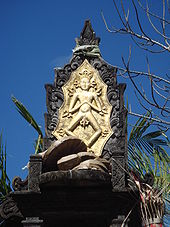

The general beliefs and practices of Agama Hindu Dharma are a mixture of aboriginal traditions and contemporary pressures placed past Indonesian laws that permit merely monotheist belief under the national ideology of panca sila.[26] [66] Traditionally, Hinduism in Indonesia had a pantheon of deities and that tradition of belief continues in practice; further, Hinduism in Republic of indonesia granted freedom and flexibility to Hindus equally to when, how and where to pray. However, officially, Indonesian regime considers and advertises Indonesian Hinduism equally a monotheistic religion with certain officially recognized behavior that comply with its national ideology.[26] [67] [68] Indonesian schoolhouse text books describe Hinduism as having one supreme being, Hindus offering three daily mandatory prayers, and Hinduism as having certain common beliefs that in function parallel those of Islam.[69] [64] Scholars competition whether these Indonesian government recognized and assigned beliefs reverberate the traditional behavior and practices of Hindus in Indonesia earlier Republic of indonesia gained independence from Dutch colonial dominion.[70] [71] [72]
Some of these officially recognized Hindu beliefs include:
- A conventionalities in ane supreme being chosen 'Ida Sanghyang Widi Wasa', 'Sang Hyang Tunggal', or 'Sang Hyang Acintya'. God Almighty in the Torajanese civilisation of Central Sulawesi is known as "Puang Matua" in Aluk To Dolo belief.[73]
- A belief that all of the gods are manifestations of this supreme being. This belief is the same every bit the belief of Smartism, which besides holds that the different forms of God, Vishnu, Siva are different aspects of the same Supreme Being. Lord Shiva is also worshiped in other forms such as "Batara Guru" and "Maharaja Dewa" (Mahadeva) are closely identified with the Sun in local forms of Hinduism or Kebatinan, and fifty-fifty in the genie lore of Muslims.[74]
- A belief in the Trimurti, consisting of:[75]
- Brahma, the creator.
- Wisnu or Vishnu, the preserver.
- Çiwa or Shiva, the destroyer.
- A belief in all of the other Hindu gods and goddesses (Hyang, Dewata and Batara-Batari).[76]
The sacred texts found in Agama Hindu Dharma are the Vedas and Upanishads.[77] They are the footing of Indian and Balinese Hinduism. Other sources of religious information include the Universal Hindu Puranas and the Itihasa (mainly Ramayana and the Mahabharata). The epics Mahabharata and Ramayana became enduring traditions amidst Indonesian believers, expressed in shadow boob (wayang) and dance performances.[78] Every bit in Bharat, Indonesian Hinduism recognizes 4 paths of spirituality, calling it Catur Marga.[79] These are bhakti mārga (path of devotion to deities), jnana mārga (path of noesis), karma mārga (path of works) and raja mārga (path of meditation). Bhakti marga has the largest following in Bali. Similarly, similar Hindus in Republic of india, Balinese Hindus believe that there are four proper goals of homo life, calling it Catur Purusartha - dharma (pursuit of moral and ethical living), artha (pursuit of wealth and creative activity), kama (pursuit of joy and love) and moksha (pursuit of self-knowledge and liberation).[80] [81]
Forms of Hinduism [edit]
Balinese Hinduism [edit]
Balinese Hinduism is an amalgamation of Indian religions and ethnic animist customs that existed in Indonesian archipelago earlier the inflow of Islam and later on Dutch colonialism.[82] Information technology integrates many of the core beliefs of Hinduism with arts and rituals of Balinese people. In contemporary times, Hinduism in Bali is officially referred past Indonesian Ministry building of Organized religion as Agama Hindu Dharma, but traditionally the religion was called by many names such as Tirta, Trimurti, Hindu, Agama Tirta, Siwa, Buda, and Siwa-Buda.[83] The terms Tirta and Trimurti emanate from Indian Hinduism, corresponding to Tirtha (pilgrimage to spirituality virtually holy waters) and Trimurti (Brahma, Vishnu and Shiva) respectively. As in Republic of india, Hinduism in Bali grew with flexibility, featuring a diverse way of life. It includes many of the Indian spiritual ideas, cherishes legends and myths of Indian Puranas and Hindu Epics, besides as expresses its traditions through unique set up of festivals and community associated with a myriad of hyangs - the local and ancestral spirits, besides as forms of brute cede that are non common in India.[84]

Balinese Hindu temple [edit]
The Balinese temple is called Pura. These temples are designed on foursquare Hindu temple plan, equally an open air worship place inside enclosed walls, connected with series of intricately decorated gates to reach its compounds.[85] Each of these temples has a more or less fixed membership; every Balinese belongs to a temple past virtue of descent, residence, or affiliation. Some house temples are associated with the family house compound (also called banjar in Bali), others are associated with rice fields, and still others with central geographic sites. In rural highlands of Bali, banua (or wanwa, forest domain) temples in each desa (village) are common.[86] The isle of Bali has over xx,000 temples, or about one temple for every 100 to 200 people.[87] Temples are defended to local spirits as well equally to deities establish in India; for example, Saraswati, Ganesha, Wisnu, Siwa, Parvati, Arjuna, and others. The temple pattern similarly amalgamate architectural principles in Hindu temples of India and regional ideas.[85]
Each individual has a family deity, called Kula dewa, who resides in the temple chosen the family temple that the individual and his family unit patronize. Balinese Hindu follow a 210-day calendar (based on rice crop and lunar cycles), and each temple celebrates its anniversary once every 210 days (the calendar is known as Pawukon agenda).[88] [89] Unique rituals and festivals of Balinese Hindus, that are not plant in Republic of india, include those related to death of a loved ane followed past cremations, cockfights, tooth filings, Nyepi and Galungan. Each temple ceremony, besides as festivals and family events such equally wedding include flowers, offerings, towering bamboos with decoration at the end and a procession. These are celebrated past the community with prayers and banquet.[82] Most festivals have a temple every bit venue, and they are often occasions for prayers, celebration of arts and community. Some traditions, in dissimilarity, involve animist rituals such every bit caru (beast claret cede) such as Tabuh Rah (lethal cockfighting) or killing of an fauna to appease buta kala (spirits of the globe) - however, the creature sacrifices are conducted outside the premises of a temple.[90] [91]
Balinese Hindu fine art [edit]
Trip the light fantastic toe, music, colorful ceremonial dresses and other arts are a notable feature of religious expression among Balinese Hindus. As in India, these expressions celebrate various mudra to limited ideas, grace, decorum and culture. Dance-drama is common. Diverse stories are expressed. For example, one involves a battle between the mythical characters Rangda the witch (representing adharma, something like disorder) and Barong the protective spirit represented with a lion mask (representing dharma), in which performers autumn into a trance, the good attempts to conquer evil, the dancers express the idea that good and evil exists within each individual, and that conquering evil implies ejecting evil from oneself.[92] Balinese paintings are notable for their highly vigorous nonetheless refined, intricate art that resembles baroque folk art with tropical themes.[93] The trip the light fantastic-drama regularly ends undecided, neither side winning, because the primary purpose is to restore balance and recognize that the battle between dharma and adharma (expert and evil) is within each person and a never ending i.[94] Barong, or dharma, is a major symbolic and ritual epitome establish in diverse festivities, dances, arts and temples.[95]
Rituals of the life wheel are also important occasions for religious expression and artistic brandish. Ceremonies at puberty, marriage, and, about notably, cremation at decease provide opportunities for Balinese to communicate their ideas about customs, status, and the afterlife.[96]
- Balinese Hindu gild
Scholars dispute the degree and nature of social stratification in medieval and gimmicky Balinese Hindu society.[97] [98] The social structure consisted of catur wangsa (four varnas) - brahmana (priests), satriya or "Deva" (warriors), waisya (merchants), and sudra (farmers, artisans, commoners).[99] There is no historical or gimmicky cultural record of untouchables in Balinese Hindu society. The wangsa - termed castes past some accounts, classes by other accounts - were functional, not hierarchical nor segregated in Hindu gild of Bali or Java. Further, there was social mobility - people could change their occupation and caste if they wished to.[100] [101] Amid the interior highlands of Bali, the desa (villages) have had no wangsa, the social status and profession of a person has been mutable, and marriages not endogamous.[102] Historical inscriptions suggest Balinese Hindu kings and village chiefs accept come from all sections of its society - priests, warriors, merchants and artisans.[103]
Hinduism in Coffee [edit]

The ninth century Prambanan Shiva temple, the largest Hindu temple in Republic of indonesia.
Both Coffee and Sumatra were subject to considerable cultural influence from the Indian subcontinent.[73] The earliest evidences of Hindu influences in Coffee can be found in 4th century Tarumanagara inscriptions scattered around modern Jakarta and Bogor.[104] In the sixth and seventh centuries many maritime kingdoms arose in Sumatra and Coffee which controlled the waters in the Straits of Malacca and flourished with the increasing sea trade between China and India and beyond. During this time, scholars from India and China visited these kingdoms to translate literary and religious texts.
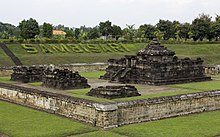
Java's Hindu temple, Candi Sambisari.
From the 4th to the 15th century, Java had many Hindu kingdoms, such as Tarumanagara, Kalingga, Medang, Kediri, Sunda, Singhasari and Majapahit. This era is popularly known as the Javanese Classical Era, during which Hindu-Buddhist literature, art and compages flourished and were incorporated into local culture under royal patronage. During this time, many Hindu temples were built, including 9th century Prambanan near Yogyakarta, which has been designated a World Heritage Site. Among these Hindu kingdoms, Majapahit kingdom was the largest and the concluding significant Hindu kingdom in Indonesian history. Majapahit was based in East Java, from where it ruled a large part of what is now Indonesia. The remnants of the Majapahit kingdom shifted to Bali during the sixteenth century after a prolonged war by and territorial losses to Islamic sultanates.[105]
The heritage of Hinduism left a significant impact and imprint in Javanese and Sundanese art and culture. The wayang puppet operation as well every bit wayang wong trip the light fantastic and other Javanese and Sundanese classical dances are derived from episodes of Hindu epics Ramayana and Mahabharata. Although the vast majority of Javanese and Sundanese now identify as Muslim, these fine art forms still survive. Hinduism has survived in varying degrees and forms on Java. Certain ethnic groups in Java, such as the Tenggerese and Osing, are also associated with Hindu religious traditions.[106]
Tengger Hindus of Java [edit]
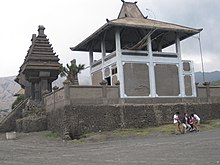
The Tengger community follows a Hindu tradition stretching back to the Majapahit Empire. At that place are strong similarities betwixt the Hinduism in Bali and the Tengger variety; both are called Hindu Dharma.[107] However, the Tengger variety does not have a caste organisation and the Tengger people's traditions are based on those originating from the Majapahit era. For the Tengger, Mount Bromo (Brahma) is believed to be a holy mountain.[108] Every year the Tengger hold a ritual known as Yadnya Kasada.[109]
Osing Hindus of Java [edit]
In spite of the Dutch attempts to propagate Islam and Christianity amidst the Osings, some of them still stuck to their old beliefs.[110] Today Hinduism nevertheless exists among the Osing population.[111] The Osings share a similar culture and spirit with the Balinese, and the Hindus celebrate ceremonies like Nyepi.[112] Just like the Balinese people, the Osing people also share the puputan tradition. The Osing people differs from the Balinese people in terms of social stratification. The Osing people does not practise caste system like the Balinese people, fifty-fifty though they are Hindus.[106]
Hinduism elsewhere in the archipelago [edit]
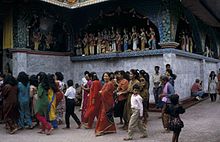
Among the non-Balinese communities considered to be Hindu past the government are, for instance, the Dayak adherents of the Kaharingan religion in Kalimantan Tengah, where government statistics counted Hindus as 15.8% of the population as of 1995[update]. Many Manusela and Nuaulu people of Seram follow Naurus, a syncretism of Hinduism with animist and Protestant elements.[8] Similarly, the Torajans of Sulawesi take identified their animistic religion Aluk To Dolo every bit Hindu. The Batak of Sumatra have identified their animist traditions with Hinduism. Among the minority Indian ethnic grouping, Tamils, Malayalis, Telugus and Punjabis of Medan, Sumatra and the Sindhis in Jakarta practice their own form of Hinduism which is similar to the Indian Hinduism, the Indians celebrating Hindu holidays more commonly found in India, such equally Deepavali and Thaipusam.[113] The Bodha sect of Sasak people on the isle of Lombok are non-Muslim; their religion is a fusion of Hinduism and Buddhism with animism; it is considered Buddhist by the government. In parts of Samarinda and Lombok especially Cakranegara, Nyepi is celebrated.[114]
A bulk of the population on the small island of Tanimbar Kei practices a variant of the Hindu organized religion, which involves a course of bequeathed worship. The isle of Tanimbar Kei is not part of Tanimbar, as the name might propose, but is one of the Kai Islands. As of 2014, it is inhabited by ca. 600 people.[115] [116]
Demographics [edit]
The Hindu organization Ditjen Bimas Hindu (DBH) carries out periodic surveys through its close connections with Hindu communities throughout Indonesia. In 2012 its studies stated that there are 10,267,724 Hindus in Republic of indonesia. The PHDI (Parisada Hindu Dharma Indonesia) along with other some other religious minority groups claim that the authorities undercounts non-Muslims in census recording.[117] The 2018 census recorded the number of Hindus at 4,646,357 with some 80% of them residing in the Hindu heartland of Bali.
Outside Bali, Hindus course a majority in Tosari commune (66.3%) in Pasuruan Regency in Java,[118] Balinggi district (77.3%) of Parigi Moutong Regency in Central Sulawesi,[118] Mappak (50%) in Tana Toraja Regency in South Sulawesi.[118] Significant Hindu population is also found in Torue (41%) and Sausu (30%) districts in Java;[118] Tomoni Timur (35%), Angkona (27%), Simbuang (36%)[118] and Tellulimpo E (forty%) districts in S Sulawesi;[118] and Cakranegara commune (39%) in Mataram in Lombok.[118]
Official Census (2018) [edit]
Co-ordinate to the 2018 census, in that location were a total of 4,646,357 Hindus in Republic of indonesia, compared to the 4,012,116 Hindus in 2010 census.[119] The percentages of Hinduism in Republic of indonesia increased from 1.69% in 2010 to 1.74% in 2018 in 8 years respectively.
| Province (2018 Cen.) | Total | Hindus | % Hindu |
|---|---|---|---|
| Indonesia | 266,534,836 | 4,646,357 | 1.74% |
| North Sumatra | fourteen,908,036 | 16,346 | 0.xi% |
| West Sumatra | 5,542,994 | 93 | 0.002% |
| Riau | 6,149,692 | 739 | 0.012% |
| Jambi | 3,491,764 | 510 | 0.02% |
| South Sumatra | eight,267,779 | 40,319 | 0.49% |
| Bengkulu | ii,001,578 | 4,184 | 0.21% |
| Lampung | 9,044,962 | 127,903 | ane.47% |
| Bangka Belitung Islands | one,394,483 | 1,193 | 0.09% |
| DKI Jakarta | 11,011,862 | xx,216 | 0.18% |
| W Java | 45,632,714 | 17,017 | 0.04% |
| Central Java | 36,614,603 | 15,648 | 0.043% |
| D.I. Yogyakarta | 3,645,487 | 3,418 | 0.09% |
| Due east Java | twoscore,706,075 | 107,971 | 0.027% |
| Banten | 10,868,810 | viii,292 | 0.08% |
| Bali | iv,236,983 | 3,682,484 | 86.91% |
| West Nusa Tenggara | 3,805,537 | 128,600 | 3.4% |
| East Nusa Tenggara | 5,426,418 | 6030 | 0.11% |
| West Borneo | 5,427,418 | 2,998 | 0.06% |
| Central Kalimantan | 2,577,215 | 155,595 | v.84% |
| S Borneo | ii,956,784 | 23,252 | 0.79% |
| E Kalimantan | 3,155,252 | eight,311 | 0.26% |
| N Sulawesi | ii,645,118 | xv,525 | 0.58% |
| Central Sulawesi | ii,969,475 | 109,308 | 4.84% |
| S Sulawesi | 9,117,380 | 63,652 | 1.02% |
| Southeast Sulawesi | i,755,193 | 50,065 | 2.97% |
| Gorontalo | ane,181,531 | ane.049 | 0.09% |
| West Papua | 1,148,154 | i,164 | 0.1% |
| Papua | 4,346,593 | 3,341 | 0.08% |
Official Census (2010) [edit]
According to the 2010 Census, at that place were a total of 4,012,116 Hindus in Indonesia, compared to 3,527,758 Hindus in 2000 Census.[120] While the absolute number of Hindus increased, the relative per centum of Hindus in Indonesia decreased from 2000 to 2010 because of lower nativity rates among the Hindu population compared to the Muslim population. The average number of births per Hindu woman varied betwixt 1.8 and ii.0 among various islands, while for the Muslim population it varied between 2.1 and 3.2 per woman.

Child dressed upwardly for a festive Hindu trip the light fantastic in Ubud, Bali

Balinese pura (Hindu temple) dance
| Province | Total | Hindu 2010 [1] | % Hindu 2010 | % Hindu 2000 | Change |
|---|---|---|---|---|---|
| Indonesia | 237,641,326 | 4,012,116 | 1.69% | 1.79% | |
| Aceh | 4,494,410 | 136 | 0.00% | 0.01% | -0.01% |
| Sumatera Utara | 12,982,204 | 122,644 | 0.eleven% | 0.17% | -0.06% |
| Sumatera Barat | four,846,909 | 234 | 0.00% | 0.00% | 0.00% |
| Riau | 5,538,367 | i,076 | 0.02% | 0.09% | -0.07% |
| Jambi | three,092,265 | 582 | 0.02% | 0.02% | 0.00% |
| Sumatera Selatan | 7,450,394 | 39,206 | 0.53% | 0.26% | 0.27% |
| Bengkulu | 1,715,518 | 3,727 | 0.22% | 0.xv% | 0.07% |
| Lampung | 7,608,405 | 113,512 | i.49% | i.44% | 0.05% |
| Kep. Bangka Belitung | ane,223,296 | 1,040 | 0.09% | 0.01% | 0.08% |
| Kepulauan Riau | one,679,163 | ane,541 | 0.09% | 0.37% | -0.28% |
| DKI Jakarta | 9,607,787 | 20,364 | 0.21% | 0.23% | -0.02% |
| Jawa Barat | 43,053,732 | 19,481 | 0.05% | 0.02% | 0.03% |
| Jawa Tengah | 32,382,657 | 17,448 | 0.05% | 0.09% | -0.04% |
| DI Yogyakarta | three,457,491 | 5,257 | 0.15% | 0.09% | 0.06% |
| Jawa Timur | 37,476,757 | 112,177 | 0.30% | 0.27% | 0.03% |
| Banten | ten,632,166 | 8,189 | 0.08% | 0.07% | 0.01% |
| Bali | three,890,757 | 3,247,283 | 83.46% | 88.05% | -iv.59% |
| Nusa Tenggara Barat | 4,500,212 | 118,083 | 2.62% | iii.03% | -0.41% |
| Nusa Tenggara Timur | four,683,827 | 5,210 | 0.11% | 0.fifteen% | -0.04% |
| Borneo Barat | 4,395,983 | 2,708 | 0.06% | 0.08% | -0.02% |
| Kalimantan Tengah | 2,212,089 | xi,149 | 0.l% | five.89% | -5.39% |
| Borneo Selatan | three,626,616 | 16,064 | 0.44% | 0.21% | 0.23% |
| Kalimantan Timur | 3,553,143 | vii,657 | 0.22% | 0.13% | 0.09% |
| Sulawesi Utara | 2,270,596 | 13,133 | 0.58% | 0.56% | 0.02% |
| Sulawesi Tengah | 2,635,009 | 99,579 | 3.78% | 4.84% | -i.06% |
| Sulawesi Selatan | 8,034,776 | 58,393 | 0.73% | 1.thirteen% | -0.40% |
| Sulawesi Tenggara | 2,232,586 | 45,441 | ii.04% | 2.97% | -0.93% |
| Gorontalo | i,040,164 | 3,612 | 0.35% | 0.00% | 0.35% |
| Sulawesi Barat | one,158,651 | xvi,042 | i.38% | 1.88% | -0.50% |
| Maluku | 1,533,506 | 5,669 | 0.37% | NA | 0.00% |
| Maluku Utara | 1,038,087 | 200 | 0.02% | 0.02% | 0.00% |
| Papua Barat | 760,422 | 859 | 0.eleven% | 0.68% | -0.57% |
| Papua | two,833,381 | 2,420 | 0.09% | 0.xvi% | -0.07% |
Official Demography (2000) [edit]
According to the 2000 census, Hindus made up one.79% of the full Indonesian population. Bali had the highest concentration of Hindus with 88.05% of its population professing Hinduism agama.[121] The per centum of Hindus in the total population declined from the 1990 demography, and this is largely attributed to lower nascence rates and clearing of Muslims from Java into provinces with high Hindu populations.[122] In Cardinal Kalimantan there has been progressive settlement of Madurese from Madura.[123] The details are given below:
| Province (2000 Cen) | Hindus | Total | % Hindu |
|---|---|---|---|
| N Sumatra | xviii,907 | 11,429,919 | 0.17% |
| Due west Sumatra | 0 | 4,220,318 | 0.00% |
| Riau | 4,385 | four,676,025 | 0.09% |
| Jambi | 410 | 2,386,866 | 0.02% |
| South Sumatra | 17,874 | 6,756,564 | 0.26% |
| Bengkulu | two,033 | 1,396,687 | 0.fifteen% |
| Lampung | 95,458 | six,631,686 | 1.44% |
| Bangka Belitung Islands | 76 | 945,682 | 0.01% |
| Djakarta | xix,331 | 8,482,068 | 0.23% |
| West Java | 8,177 | 35,279,182 | 0.02% |
| Central Java | 28,677 | 30,775,846 | 0.09% |
| D.I. Yogyakarta | ii,746 | 3,026,209 | 0.09% |
| Eastward Java | 92,930 | 34,456,897 | 0.27% |
| Banten | five,498 | 7,967,473 | 0.07% |
| Bali | two,740,314 | three,112,331 | 88.05% |
| Nusa Tenggara Barat | 115,297 | iii,805,537 | 3.03% |
| Nusa Tenggara Timur | v,698 | iii,904,373 | 0.fifteen% |
| West Kalimantan | ii,914 | 3,721,368 | 0.08% |
| Cardinal Kalimantan | 105,256 | 1,785,875 | 5.89% |
| South Kalimantan | 6,288 | 2,956,784 | 0.21% |
| E Kalimantan | 3,221 | 2,414,989 | 0.13% |
| North Sulawesi | 10,994 | ane,972,813 | 0.56% |
| Central Sulawesi | 99,443 | 2,053,167 | iv.84% |
| South Sulawesi | 87,660 | seven,759,574 | i.13% |
| Southeast Sulawesi | 52,103 | 1,755,193 | 2.97% |
| Gorontalo | 0 | 833,720 | 0.00% |
| Irian Jaya | ii,068 | 2,094,803 | 0.ten% |
| Republic of indonesia | iii,527,758 | 196,601,949 | 1.79% |
Hindu holidays in Indonesia [edit]

Street ornamentation in Bali for the Hindu festival Galungan. It celebrates the victory of dharma over adharma (right over wrong).[124]
- Hari Raya Galungan occurs every 210 days and lasts for 10 days.[125] Information technology celebrates the coming of the gods and the ancestral spirits to earth to dwell again in the homes of their descendants. The festivities are characterized by offerings, dances and new clothes.[126] The ancestors must be suitably entertained and welcomed, and prayers and offerings must be made for them. Families whose ancestors accept non been cremated withal, but remain buried in the village cemetery, must make offerings at the graves. Kuningan is the last day of the holiday, when the gods and ancestors depart until the next Galungan.[127] [128]
- Hari Raya Saraswati is dedicated to the goddess of learning, science, and literature.[129] She rules the intellectual and creative realm, and is the patron goddess of libraries and schools. Balinese Hindus believe that cognition is an essential medium to attain the goal of life as a homo existence, and so honor her. She is as well celebrated because she succeeded in taming the wandering and lustful mind of her consort, Brahma, who was preoccupied with the goddess of material existence, Shatarupa. On this day, offerings are made to the lontar (palm-foliage manuscripts), books, and shrines. Saraswati Day is celebrated every 210-days on Saniscara Umanis Wuku Watugunung and marks the offset of the new year according to the Balinese Pawukon calendar.[130] Ceremonies and prayers are held at the temples in family compounds, educational institutions and temples, villages, and businesses from forenoon to apex. Teachers and students replace their uniforms for the day with bright and colorful ceremonial vesture, filling the island with color. Children bring fruit and traditional cakes to school for offerings at the temple.[131]
- Hari Raya Nyepi is a Hindu Day of Silence or the Hindu New Year in the Balinese Saka calendar. The largest celebrations are held in Bali also as in Balinese Hindu communities around Republic of indonesia. On New Year'south Eve the villages are cleaned, food is cooked for two days and in the evening as much noise is made as possible to scare away the devils. On the following day, Hindus do not leave their homes, cook or engage in any activeness. Streets are deserted, and tourists are not immune to leave hotel complexes. The day following Nyepi night, everything stops for a day except emergency services such as ambulances.[132] Nyepi is determined using the Balinese calendar, the eve of Nyepi falling on the night of the new moon whenever information technology occurs around March/April each year. Therefore, the date for Nyepi changes every yr. Nyepi night is a night of community gathering and burning of effigies island-wide (similar to Karthikai in South India), while the next 24-hour interval is the day of full peace and serenity.
[edit]

A common feature amidst new Hindu communities in Java is that they tend to rally around recently built temples (pura) or around archaeological temple sites (candi) which are existence reclaimed as places of Hindu worship.[133]
The Parisada Hindu Dharma inverse its name to Parisada Hindu Dharma Indonesia in 1984, in recognition of its national influence spearheaded past Gedong Bagus. One of several new Hindu temples in eastern Java is Pura Mandaragiri Sumeru Agung, located on the slope of Mt. Semeru, Java'southward highest mountain. When the temple was completed in July 1992, with the generous help of wealthy donors from Bali, only a few local families formally confessed to Hinduism. A pilot study in Dec 1999 revealed that the local Hindu community at present has grown to more than 5000 households.
Similar mass conversions have occurred in the region around Pura Agung Blambangan, some other new temple, built on a site with small archaeological remnants attributed to the kingdom of Blambangan, the last Hindu polity on Java.[134] A further important site is Pura Loka Moksa Jayabaya (in the village of Menang near Kediri), where the Hindu male monarch and prophet Jayabaya is said to have achieved spiritual liberation (moksa).[135]

A further Hindu movement in the earliest stages of development was observed in the vicinity of the newly completed Pura Pucak Raung (in the Eastern Javanese district of Glenmore), which is mentioned in Balinese literature as the place where the Hindu saint Maharishi Markandeya gathered followers for an expedition to Bali, whereby he is said to accept brought Hinduism to the isle in the fifth century Advert.[136] An instance of resurgence effectually major archaeological remains of aboriginal Hindu temple sites was observed in Trowulan near Mojokerto. The site may exist the location of the capital of the Hindu empire Majapahit.[137] A local Hindu movement is struggling to gain control of a newly excavated temple building which they wish to see restored equally a site of agile Hindu worship. The temple is to exist dedicated to Gajah Mada, the man attributed with transforming the pocket-sized Hindu kingdom of Majapahit into an empire.[138]

In Karanganyar region in Primal Coffee, the renovated 14th century Cetho temple on the gradient of Mount Lawu has become the center of Javanese Hinduism and gain patronage of Balinese temples and royal houses.[139] A new temple is being built E of Solo (Surakarta). It is a Hindu temple that has miniatures of 50 sacred sites around the world. It is also an active kundalini yoga meditation center teaching the sacred Javanese tradition of sun and water meditation.[140] There are many westerners as well equally Javanese joining in.
Although there has been a more than pronounced history of resistance to Islamization in E Java, Hindu communities are besides expanding in Central Java (Lyon 1980), for case in Klaten, about the aboriginal Hindu monuments of Prambanan. Today the Prambanan temple stages various almanac Hindu ceremonies and festivals such as Galungan and Nyepi.[141]
In West Java, a Hindu temple Pura Parahyangan Agung Jagatkarta was congenital on the slope of Mount Salak near the historic site of ancient Sunda Kingdom capital, Pakuan Pajajaran in modern Bogor. The temple, dubbed every bit the largest Balinese Hindu temple ever congenital outside Bali, was meant equally the main temple for the Balinese Hindu population in the Greater Jakarta region.[142] Yet, because the temple stands in a Sundanese sacred identify, and also hosts a shrine dedicated to the famous Sundanese king, Prabu Siliwangi, the site has gained popularity amongst locals who wish to reconnect their ties with their ancestors.
Tourism [edit]

Colourful and festive Hindu rituals of Bali is one of island'southward attractions.
The predominantly Hindu isle of Bali is the largest tourist describe in Indonesia.[143] Next to natural beauty, the temple architecture, the elaborate Hindu festivals, rich culture, colorful art and vivid dances are the main attractions of Balinese tourism. Equally a result, tourism and hospitality services are flourishing as one of the near of import sources of income and generation of Balinese economy.[144] The high tourist activity in Bali is in contrast with other provinces in Republic of indonesia where the Hindu population is not significant or is absent-minded.[145]
The Government of Indonesia also invests and focuses on the Ancient sites and buildings of Hindu religion, forth with Buddhist ones.
Culture [edit]
Before Islamization of Indonesia, the art and culture of Indonesia was deepely affected by the Hindu culture.[146] Fifty-fifty in the mod Republic of indonesia, many Indonesian Muslims and Christians, especially in Bali, Coffee and other islands follows the culture and traditions like that of Hindus.[α] In that location are many well known and often visited Hindu temples in Indonesia, many of them are present in the islands are a adept places for worship and tourism.
Temples [edit]
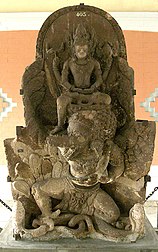
The Hindu temple construction and architecture in Indonesia differs from the rest part of the world and has also serenity diversity amongst them as well.[149] The temples structures in Indonesia can be classified in 3 ways:
- Candi, the Javanese ancient Hindu temple.[150] (This type of temple structure and architecture is mostly founded in Coffee and are place of worship for Javanese Hindus).
- Pura, the Balinese temples.[151] (A Pura is a Balinese temple and is identify of worship for Balinese Hindus).
- Kuil or mandir, the Indian Hindu temples.[152] (It is normal temple with a Gopuram and is similar temples like elsewhere).[β]
Symbolism [edit]
The Hindu civilisation and practices insipires many modern symbols and has crucial role in Indonesian history and also in present scenario.
- The National emblem of Republic of indonesia is called Garuda Pancasila.[154] Garuda, the discipled carrier or vehicle (vahana) of Lord Vishnu, appears in many ancient Hindu temples of ancient Republic of indonesia.[155] Garuda Pancasila was designed past Sultan Hamid II from Pontianak, supervised by Sukarno, and was adopted every bit the national emblem on 11 February 1950.[156] The Garuda Indonesia, the national airline of Indonesia is said to be insipired from the same Garuda.
- In that location are many names of Indonesians, including Muslims and Christians have Sanskrit or Hindu deities names, such as Wisnu, Surya, etc.[157]
Notable Hindus [edit]
Monarchs [edit]

- Kudungga
- Mulavarman
- Purnawarman
- Adityawarman
- Airlangga
- Anak Wungsu
- Agung Anom
- Anusapati
- Arjayadengjayaketana
- Ken Arok
- Balitung
- Dalem Baturenggong
- Dalem Ketut
- Dalem Samprangan
- Dharmawangsa
- Hayam Wuruk
- Isyana Tunggawijaya
- Jayabaya
- Jayakatwang
- Jayanegara
- Jayapangus
- Samara Vijayatunggavarman
- Sanjaya of Mataram
- Sanna
- Siliwangi
- Mpu Sindok
- Sri Baduga Maharaja
- Śri Wijaya Mahadewi
- Suhita
- Ide Anak Agung Gde Agung
Religious leaders [edit]
- Ratu Bagus
- Ida Pedanda Gede Made Gunung
- Jayabaya
- D. Kumaraswamy
- Mangku Muriati
- Dang Hyang Nirartha
- Sabdapalon
- Ketut Wiana
Modern-solar day Hindus [edit]
- Happy Salma
- Ade Rai
- Manoj Punjabi
- Raam Punjabi
- Swami Anand Krishna
- Sri Prakash Lohia
- I Wayan Koster
- Dewa Budjana
- Sukmawati Sukarnoputri
Run across as well [edit]
- Acintya
- Balinese Hinduism
- Candi of Republic of indonesia
- Hinduism in Java
- Hinduism in Southeast Asia
- Dewi Sri
- Hinduism in Bali
- List of Hindu empires and dynasties
- Hyang
- Indians in Indonesia
- List of Hindu temples in Indonesia
- Faith in Indonesia
- Sanskritization
- Trisandya
References [edit]
Notes [edit]
- ^ The lower number is based on Pew Enquiry approximate and is primarily concentrated in the island of Bali, Indonesia and nearby provinces of Indonesia. The higher number is based on a 2010 estimate past the Ministry of Religious Affairs of the Government of Republic of indonesia.[eight] The largest Hindu organization in Indonesia Parisada Hindu Dharma Republic of indonesia states that the Indonesian census greatly underestimates Hindu population, because predominantly Muslim nation of Indonesia does not recognize all forms of Hinduism, and only recognizes monotheistic Hinduism under its constitution.[147] [148]
- ^ Well-nigh of the Hindu temple, or Mandir are found in India and other places. They have Gopuramas and Vimana. They have different architecture as compared to Balinese temple and Candi.[153]
Citations [edit]
- ^ a b c "Sensus Penduduk 2010 - Penduduk Menurut Wilayah dan Agama yang Dianut". sp2010.bps.get.id. Retrieved 2014-05-27 .
- ^ Religious Liberty Report - Indonesia U.S. State Department (2012)
- ^ Juergensmeyer, Mark; Roof, Wade Clark (2012). Encyclopedia of Global Religion. SAGE Publications. pp. 557. ISBN978-0-7619-2729-7.
- ^ "Mahayana Buddhism: Buddhism in Indonesia". www.buddhanet.net. Archived from the original on 2020-xi-12. Retrieved 2021-02-07 .
- ^ Cox, Murray P.; Nelson, Michael G.; Tumonggor, Meryanne G.; Ricaut, François-X.; Sudoyo, Herawati (2012-07-22). "A small cohort of Island Southeast Asian women founded Madagascar". Proceedings of the Royal Society B: Biological Sciences. 279 (1739): 2761–2768. doi:10.1098/rspb.2012.0012. ISSN 0962-8452. PMC3367776. PMID 22438500.
- ^ Campo, Juan Eduardo (2009). Encyclopedia of Islam. Infobase Publishing. pp. 72. ISBN978-ane-4381-2696-eight. OCLC 1126059704.
- ^ Kahin, Audrey (2015-10-29). Historical Dictionary of Indonesia. Rowman & Littlefield. pp. 3–5. ISBN978-0-8108-7456-5.
- ^ a b c Indonesia: Religious Freedoms Report 2010, US State Department (2011), Quote: "The Ministry building of Religious Affairs estimates that 10 meg Hindus live in the country and account for approximately ninety pct of the population in Bali. Hindu minorities besides reside in Fundamental and East Kalimantan, the metropolis of Medan (Due north Sumatra), S and Central Sulawesi, and Lombok (West Nusa Tenggara). Hindu groups such as Hare Krishna and followers of the Indian spiritual leader Sai Baba are present in small numbers. Some indigenous religious groups, including the "Naurus" on Seram Island in Maluku Province, comprise Hindu and animist beliefs, and many accept also adopted some Protestant teachings."
- ^ "Tabular array: Religious Composition by Country, in Numbers". Pew Enquiry Centre's Religion & Public Life Project. 2012-12-18. Retrieved 2021-05-04 .
- ^ "Republic of indonesia". U.S. Department of Land . Retrieved 2021-05-04 .
- ^ The United States Department of State Annual Report on International Religious Freedom for 2006 - Indonesia - September 2006, US Country Section "Archived re-create". Archived from the original on xix October 2006. Retrieved 2006-11-02 .
{{cite web}}: CS1 maint: archived copy as championship (link) - ^ Indonesia International Religious Freedom Study 2005 – US Country Department, Quote: "The Hindu clan Parishada Hindu Dharma Indonesia (PHDI) estimates that eighteen million Hindus alive in the country, a effigy that far exceeds the government estimate of 3.six one thousand thousand. Hindus account for almost 90 pct of the population in Bali."
- ^ Focus on Indonesia. Information Division, Embassy of Indonesia. 1977. pp. 21. OCLC 2116026.
- ^ Damle & Damle 2020, pp. 76–89.
- ^ Greenfieldt, John; Bartell, Patrice (2008). Public Library Core Collection: A Option Guide to Reference Books and Adult Nonfiction. Nonfiction. H.W. Wilson Company. pp. 1186. ISBN978-0-8242-1094-six.
- ^ Ooi, Keat Gin (2004). Southeast Asia: A Historical Encyclopedia, from Angkor Wat to Eastward Timor. ABC-CLIO. pp. 175–190. ISBN978-1-57607-770-ii.
- ^ January Gonda, The Indian Religions in Pre-Islamic Republic of indonesia and their survival in Bali, in Handbook of Oriental Studies. Department iii Southeast Asia, Religions, p. ane, at Google Books, pp. 1-54
- ^ Bade, David (2013-09-04). Of Palm Vino, Women and War: The Mongolian Naval Expedition to Java in the 13th Century. Found of Southeast Asian Studies. pp. 233. ISBN978-981-4517-82-9.
- ^ Pringle 2004, p. vii.
- ^ Picard & Madinier 2011, pp. 67–71.
- ^ Pringle 2004, pp. eleven–24; Hefner 2018, pp. 23–26.
- ^ a b Gonda, Jan (1975-01-01). Handbook of Oriental Studies. Department three Southeast Asia, Religions, Religionen. BRILL. p. 1. ISBN978-xc-04-04330-5.
- ^ Soekmono, R. (1973). Pengantar sejarah kebudayaan Republic of indonesia (in Indonesian). Yayasan Kanisius. p. 119.
- ^ Hall, Kenneth R. (2010-12-28). A History of Early Southeast Asia: Maritime Trade and Societal Development, 100–1500. Rowman & Littlefield Publishers. pp. 40–55. ISBN978-0-7425-6762-7.
- ^ Hall, Kenneth R. (2010-12-28). A History of Early Southeast Asia: Maritime Trade and Societal Development, 100–1500. Rowman & Littlefield Publishers. pp. 122–123. ISBN978-0-7425-6762-vii.
- ^ a b c d e McDaniel, June (2010-08-01). "Agama Hindu Dharma Republic of indonesia as a New Religious Movement: Hinduism Recreated in the Image of Islam". Nova Religio. 14 (1): 93–111. doi:ten.1525/nr.2010.14.i.93. ISSN 1092-6690.
- ^ John, Guy (2014-04-07). Lost Kingdoms: Hindu-Buddhist Sculpture of Early Southeast Asia. Metropolitan Museum of Art. pp. 130–135. ISBN978-1-58839-524-5.
- ^ Dalsheimer, Nadine; Manguin, Pierre-Yves (1998). "Visnu mitrés et réseaux marchands en Asie du Sud-Est : nouvelles données archéologiques sur le Ier millénaire apr. J.-C". Bulletin de l'École française d'Extrême-Orient. 85 (1): 87–123. doi:10.3406/befeo.1998.2545.
- ^ Simanjuntak, Truman (2006). Archaeology: Indonesian Perspective : R.P. Soejono's Festschrift. Yayasan Obor Indonesia. pp. 406–419. ISBN978-979-26-2499-1.
- ^ Hefner 2018, p. 91.
- ^ Ramstedt 2005, pp. 89–93; Hefner 2018, pp. 98–103.
- ^ Gonda, Jan (1975-01-01). Handbook of Oriental Studies. Section 3 Southeast Asia, Religions, Religionen. BRILL. p. fourteen. ISBN978-ninety-04-04330-5.
- ^ Aiyar, Pallavi (2013-10-14). "Lessons from Indonesia'south Hindu legacy". The Hindu. ISSN 0971-751X. Retrieved 2021-02-06 .
{{cite news}}: CS1 maint: url-status (link) - ^ Gerhard Bowering et al. (2012), The Princeton Encyclopedia of Islamic Political Thought, Princeton University Press, ISBN 978-0691134840, pp. xvi
- ^ Tanasaldy, Taufiq (2012). Authorities Change and Ethnic Politics in Republic of indonesia: Dayak Politics of Westward Borneo. BRILL. ISBN978-90-04-25348-3.
- ^ Bowering, Gerhard; Crone, Patricia; Kadi, Wadad; Mirza, Mahan; Stewart, Devin J.; Zaman, Muhammad Qasim (2013). The Princeton Encyclopedia of Islamic Political Thought. Princeton University Press. ISBN978-0-691-13484-0.
- ^ Morgan, David O.; Reid, Anthony (2010-11-04). The New Cambridge History of Islam: Volume 3, The Eastern Islamic World, Eleventh to Eighteenth Centuries. Cambridge University Press. ISBN978-1-316-18436-3.
- ^ Pringle, Robert (2010). Agreement Islam in Indonesia: Politics and Multifariousness. University of Hawaiʻi Press. pp. 125. ISBN978-0-8248-3415-ix.
- ^ James Play tricks, Indonesian Heritage: Religion and ritual, Volume 9 of Indonesian heritage, Editor: Timothy Auger, ISBN 978-9813018587
- ^ STAFF, MERRIAM-WEBSTER; Inc, Merriam-Webster (1999). Merriam-Webster's Encyclopedia of Globe Religions. Merriam-Webster. pp. 516–517. ISBN978-0-87779-044-0.
- ^ Taylor, Jean Gelman (2003-01-01). Indonesia: Peoples and Histories. Yale University Press. pp. 21–83. ISBN978-0-300-10518-vi.
- ^ Ramstedt 2005, p. 9-11.
- ^ Ramstedt 2005, p. 12.
- ^ Ramstedt 2005, pp. 13–xv.
- ^ Ramstedt 2005, pp. 15–16; Pringle 2004, pp. 78–81.
- ^ Picard & Madinier 2011, pp. 56–74.
- ^ Ramstedt 2005, pp. 34–37.
- ^ "Balinese Hinduism - Bali.com - Religion of Harmony, Holy H2o, Ancestors". Bali.com. 2020-08-xviii. Retrieved 2021-02-07 .
- ^ Ramstedt 2005, pp. 12–sixteen.
- ^ BAKKER, FREEK L. (1997). "Balinese Hinduism and the Indonesian Land: Recent Developments". Bijdragen tot de Taal-, Land- en Volkenkunde. 153 (1): 15–41. doi:x.1163/22134379-90003943. ISSN 0006-2294. JSTOR 27864809.
- ^ Ramstedt 2005, pp. 17–18.
- ^ Ramstedt, Martin (2008). "Hindu Bonds at Work: Spiritual and Commercial Ties between Bharat and Bali". The Journal of Asian Studies. 67 (four): 1227–1250. doi:10.1017/S0021911808001769. ISSN 1752-0401. S2CID 46562270.
- ^ Ramstedt 2005, pp. 57–56.
- ^ Ramstedt 2005, p. 17, xix-21.
- ^ Ramstedt 2005, pp. 17–20.
- ^ Hosen, Northward (2005-09-08). "Organized religion and the Indonesian Constitution: A Recent Debate" (PDF). Journal of Southeast Asian Studies. Cambridge University Press. 36 (3): 419–440. doi:10.1017/S0022463405000238. S2CID 1636786. Archived from the original (PDF) on August 28, 2006. Retrieved 2006-10-26 .
- ^ Relations, United States Congress House Committee on International (2001). Annual Report on International Religious Freedom 2001: Written report Submitted to the Committee on International Relations, U.S. House of Representatives and the Committee on Strange Relations, U.Southward. Senate. U.S. Regime Printing Office. p. 150.
- ^ Aritonang, Jan Sihar; Steenbrink, Karel Adriaan (2008). A History of Christianity in Republic of indonesia. BRILL. pp. 160–164. ISBN978-90-04-17026-1.
- ^ "Special Feature: See The Hindus of Java - Magazine Web Edition October/November/Dec 2014 - Publications - Hinduism Today Magazine". www.hinduismtoday.com. Archived from the original on 2020-11-12. Retrieved 2021-02-07 .
- ^ McDaniel, June (2017-07-16). "Religious modify and experimentation in Indonesian Hinduism". International Journal of Dharma Studies. 5 (1): xx. doi:10.1186/s40613-017-0056-10. ISSN 2196-8802.
- ^ Esposito, John L.; Shahin, Emad El-Din (2013k). The Oxford Handbook of Islam and Politics. OUP U.s.a.. pp. 570–571. ISBN978-0-19-539589-1.
- ^ Aiyar, Pallavi (2013-10-14). "Lessons from Indonesia'due south Hindu legacy". The Hindu. ISSN 0971-751X. Archived from the original on 2021-01-27. Retrieved 2021-02-07 .
- ^ KUMAR 2014, pp. 78–79.
- ^ a b McDaniel, June (2013-11-01). "A Modern Hindu Monotheism: Indonesian Hindus every bit 'People of the Book'". The Journal of Hindu Studies. 6 (3): 333–362. doi:10.1093/jhs/hit030. ISSN 1756-4255.
- ^ "Jokowi creates country's first Hindu land academy". The Djakarta Post . Retrieved 2021-02-07 .
- ^ Yamashita 2003, p. 56.
- ^ Yamashita 2003, pp. 58–61.
- ^ Picard & Madinier 2011, pp. 56–72.
- ^ Yamashita 2003, p. 70.
- ^ Setia, Putu (1992). Cendekiawan Hindu bicara (in Indonesian). Yayasan Dharma Maradha. p. 371. ISBN978-979-8357-00-8.
- ^ Picard & Madinier 2011, p. 111-114.
- ^ Yamashita 2003, pp. 71–72.
- ^ a b "Modi in Jakarta: How Muslim-majority Indonesia keeps its Hinduism alive". India Today. May 30, 2018. Retrieved 2021-02-07 .
- ^ Kekai, Paul (2005-02-02). "Quests of the Dragon and Bird Clan: Wednesday, February 02, 2005". Sambali.blogspot.com. Retrieved 2010-07-19 .
- ^ "Brahma Vishnu Mahesh Trimurti Puja - Rudraksha Ratna". www.rudraksha-ratna.com . Retrieved 2021-02-07 .
- ^ Reuter, Thomas (2001). "Great Expectations: Hindu Revival Movements in Java". The Australian Journal of Anthropology. 12 (3): 327–338. doi:10.1111/j.1835-9310.2001.tb00081.x. ISSN 1757-6547.
- ^ Ramstedt 2005, pp. 91–95.
- ^ Xing, Jun; Ng, Pak-sheung (2015-10-23). Indigenous Culture, Instruction and Globalization: Critical Perspectives from Asia. Springer. pp. v–11. ISBN978-3-662-48159-2.
- ^ "SINTA - Science and Technology Index". sinta.ristekbrin.become.id . Retrieved 2021-02-07 .
- ^ Widya Dharma Agama Hindu SMP kls ix (in Indonesian). Ganeca Exact. ISBN978-979-744-740-3.
- ^ Sugandhi, I. G. P. (2005). "SENI (RUPA) BALI HINDU DALAM PERSPEKTIF EPISTEMOLOGI BRAHMA WIDYA". Ornamen. 2 (1): 58–69. ISSN 2685-614X.
- ^ a b Simmonds, Nigel (2013-12-24). Bali Morning of the World. Tuttle Publishing. pp. 41–43. ISBN978-i-4629-1359-6.
- ^ Picard & Madinier 2011, p. Chapter-v.
- ^ Picard & Madinier 2011, p. chapter-half dozen.
- ^ a b Davison, Julian; Tettoni, Luca Invernizzi; Enu, Nengah (2003-10-15). Introduction to Balinese Architecture. Periplus Editions (HK) Limited. pp. 32–45. ISBN978-0-7946-0071-six.
- ^ Journal of Southeast Asian Studies. Cambridge University Press. 2003. p. 170.
- ^ Janet Descutner (2004), Asian Trip the light fantastic toe, ISBN 978-0791077771, pp. 66
- ^ McCarthy, Daniel (1998). "Review of Calendrical Calculations". Isis. 89 (four): 703–704. doi:10.1086/384162. ISSN 0021-1753. JSTOR 236740.
- ^ Kelley, David H. (2016-07-22). "Book Review: Calendrical Systems Explored: Calendrical Calculations, Mapping Fourth dimension: The Agenda and its History". Journal for the History of Astronomy. thirty (four): 407–409. Bibcode:1999JHA....30..407D. doi:x.1177/002182869903000404. S2CID 126134279.
- ^ Reuter, Thomas A. (2002-01-31). Custodians of the Sacred Mountains: Culture and Society in the Highlands of Bali. University of Hawaii Press. ISBN978-0-8248-6210-vii.
- ^ Eliot, Joshua; Bickersteth, Jane; Capaldi, Liz (1996). Indonesia Handbook. Footprint Handbooks. p. 461. ISBN978-0-8442-4910-0.
- ^ Eiseman, Fred and Margaret (1988). Woodcarving of Bali. Periplus.
- ^ Forge, Anthony (1978). "Balinese Traditional Paintings" (PDF). The Australian Museum. Archived (PDF) from the original on 20 Dec 2021. Retrieved 20 Dec 2016.
- ^ Belo, Jane (1966). Bali: Rangda and Barong. University of Washington Press.
- ^ Reuter, Thomas A. (2002-01-31). Custodians of the Sacred Mountains: Civilization and Society in the Highlands of Bali. University of Hawaii Printing. pp. 171, 202–203. ISBN978-0-8248-6210-vii.
- ^ Yamashita 2003, p. 68.
- ^ Picard & Madinier 2011, p. Chapter-VI (56).
- ^ "Results | Scholars Portal Journals". journals.scholarsportal.info . Retrieved 2021-02-07 .
- ^ HOWE, L. E. A. (1989). "Hierarchy and Equality: Variations in Balinese Social Organization". Bijdragen tot de Taal-, Land- en Volkenkunde. 145 (1): 47–71. doi:ten.1163/22134379-90003268. ISSN 0006-2294. JSTOR 27863998.
- ^ Hefner 1990, p. 67.
- ^ Kapur, in The Lab, the Temple, and the Market (Editor: Sharon Harper), ISBN 978-0889369207, pp. 26-27
- ^ Thomas Anton Reuter (2002), Custodians of the Sacred Mountains: Culture and Society in the Highlands of Bali, University of Hawaii Press, ISBN 978-0824824501, Chapter one
- ^ Picard & Madinier 2011, p. 781.
- ^ Hefner 1990, pp. 198–199; Ramstedt 2005, pp. 78–90; KUMAR 2014, pp. 41.
- ^ Jean Gelman Taylor, Indonesia: Peoples and Histories, Yale University Press, ISBN 978-0300105186, pp. 21-83 and 142-173
- ^ a b Hefner 2018.
- ^ "Tengger: The ethnic minority which protects Hinduism in remote part of Indonesia!". CT. 2018-02-08. Retrieved 2021-02-07 .
- ^ Kalpavriksha (2019-12-26). "The Tengger people of Coffee, descendants of Majapahit". Medium . Retrieved 2021-02-07 .
- ^ Images, Ulet Ifansasti/Getty (2015-08-07). "Yadnya Kasada festival - in pictures". The Guardian. ISSN 0261-3077. Retrieved 2021-02-07 .
{{cite news}}: CS1 maint: url-status (link) - ^ Project, Joshua. "Osing in Indonesia". joshuaproject.net . Retrieved 2021-02-07 .
- ^ Wessing, Robert (2013-11-01). "The Osing Agricultural Spirit-Medium". Moussons. Recherche en Sciences Humaines Sur fifty'Asie du Sud-Est (22): 111–124. doi:10.4000/moussons.2406. ISSN 1620-3224.
- ^ Java : garden of the East. Internet Archive. Lincolnwood, Ill., Usa : Passport Books. 1994. pp. 283. ISBN978-0-8442-9947-i.
{{cite book}}: CS1 maint: others (link) - ^ My Jakarta: Bhavana Sutrisna Tirtadinata The Jakarta World — March 14, 2009
- ^ "Babad Bali - Pelaks Nyepi". www.babadbali.com . Retrieved 2021-02-08 .
- ^ Jayanti, Anes D.; Osozawa, Katsuya (2014). "Sasi in Kei Island: Transformation of Littoral Resources Managementby Community in Tanimbar Kei Island, Maluku, Indonesia". Jurnal Perikanan. sixteen (ane): 43–52.
- ^ Steenbergen, Dirk J. (2016). "Strategic Customary Village Leadership in the Context of MarineConservation and Development in Southeast Maluku, Indonesia". Man Environmental. 44 (3): 311–327. doi:10.1007/s10745-016-9829-half dozen. PMC4937095. PMID 27445428.
- ^ United nations Loftier Commissioner for Refugees. "Refworld | 2010 Written report on International Religious Freedom - Indonesia". unhcr.org. Archived from the original on 2012-x-19. Retrieved 2014-05-27 .
- ^ a b c d e f g "Peringatan". sp2010.bps.get.id . Retrieved 2021-02-06 .
- ^ "Statistik Umat Menurut Agama di Indonesia" (in Indonesian). Kementerian Agama Republik Republic of indonesia. 15 May 2018. Archived from the original on 3 September 2020. Retrieved fifteen Nov 2020.
Muslim 231.069.932 (86.7), Christian 20.246.267 (7.half-dozen), Catholic eight.325.339 (3.12), Hindu 4.646.357 (1.74), Buddhist 2.062.150 (0.77), Confucianism 117091 (0.03), Other 299617 (0.13), Not Stated 139582 (0.06), Non Asked 757118 (0.32), Full 237641326
- ^ The data in present in 2010 Indonesian census.
- ^ Data Umat Hindu Tahun 2009 Archived 2012-04-25 at the Wayback Machine
- ^ Internal Displacement Monitoring Middle (IDMC) - Norwegian Refugee Council. "West and Key Kalimantan: Limited livelihood opportunities and failed compensation for lost property hamper recovery of Madurese returnees". Internal-displacement.org. Archived from the original on 2010-07-31. Retrieved 2010-07-19 .
- ^ "Indonesia". State.gov. Retrieved 2010-07-nineteen .
- ^ Eiseman, Fred (1989), Bali: Sekala and Niskala Book I: Essays on Religion, Ritual and Art, Periplus Editions, ISBN 0-945971036
- ^ Focus on Indonesia. Information Division, Diplomatic mission of Indonesia. 1976. p. 31.
- ^ "Calendar Of Events". Bali Local Guide . Retrieved 2021-02-08 .
- ^ Waldmeier, Elisabeth (2012-08-07). Sadri Returns to Bali: A Tale of the Balinese Galungan Festival. Tuttle Publishing. pp. 67–89. ISBN978-1-4629-0873-8.
- ^ Ramstedt 2005, pp. 196–198.
- ^ Eiseman, Fred B.; Eiseman, Margaret H. (1989). Bali, Sekala and Niskala: Essays on religion, ritual, and fine art. Periplus Editions. p. 183. ISBN978-0-945971-03-0.
- ^ Dershowitz, Nachum; Reingold, Edward K. (2008). Calendrical Calculations. Cambridge University Printing. p. 187. ISBN978-0-521-88540-9.
- ^ "Bali Cultural Ceremony and Ritual". Balispirit.com. Retrieved 2010-07-19 .
- ^ Nyoman Southward. Pendit (2001), Nyepi: kebangkitan, toleransi, dan kerukunan, Gramedia Pustaka Indonesia, ISBN 978-9796865710
- ^ Kinney, Ann R.; Klokke, Marijke J.; Kieven, Lydia (2003-01-01). Worshiping Siva and Buddha: The Temple Art of East Java. Academy of Hawaii Press. ISBN978-0-8248-2779-3.
- ^ Pringle 2004, p. 17.
- ^ KUMAR 2014.
- ^ "Biographies,Sages, Rushis And Saints at FreeIndia". Archived from the original on 16 March 2008. Retrieved 8 February 2021.
- ^ KUMAR 2014, pp. 89–123; Hefner 1990, pp. 137.
- ^ Devi, Sita W. "Tracing the glory of Majapahit". The Jakarta Mail. Archived from the original on 2020-07-02. Retrieved 2021-02-08 .
- ^ "10 Most Beautiful Temples in Republic of indonesia". Touropia. Archived from the original on 2020-12-12. Retrieved 2021-02-08 .
- ^ "Special Characteristic: Exploring the Temples of Java, Republic of indonesia - Magazine Web Edition Jan/February/March 2015 - Publications - Hinduism Today Magazine".
- ^ Federspiel, Howard M. (2007-01-01). Sultans, Shamans, and Saints: Islam and Muslims in Southeast Asia. University of Hawaii Printing. p. 52. ISBN978-0-8248-3052-vi.
- ^ "ResearchGate" (01). doi:10.18784/analisa.v2i01.412.
- ^ "Foreign Tourist Arrivals to Republic of indonesia Leap 22.6% in Jan 2014 | Indonesia Investments". www.indonesia-investments.com . Retrieved 2021-02-08 .
- ^ Vickers, Adrian (2013-08-xiii). Bali: A Paradise Created. Tuttle Publishing. p. 252. ISBN978-1-4629-0008-four.
- ^ "Statistics - Dinas Pariwisata". 2016-09-07. Archived from the original on 2016-09-07. Retrieved 2021-02-06 .
- ^ Hefner 1990, p. 10 (folio end).
- ^ F.Yard. Bakker (1997), Balinese Hinduism and the Indonesian State: Recent Developments, Bijdragen tot de Taal-, Country- en Volkenkunde, Deel 153, 1ste Afl., Brill Academic, pp. 15–41
- ^ Martin Ramstedt (2004). Hinduism in Mod Republic of indonesia: A Minority Religion Between Local, National, and Global Interests. Routledge. pp. vii–12. ISBN978-0-7007-1533-half-dozen.
- ^ Juergensmeyer, Marker; Roof, Wade Clark (2012). Encyclopedia of Global Religion. SAGE. ISBN978-0-7619-2729-7.
- ^ "Temples in Bali - Bali Directory - Information about resource in Bali - Designed and Managed by bali3000". world wide web.bali3000.com. Archived from the original on 2010-05-eleven. Retrieved 2021-05-04 .
- ^ "JOURNAL OF THE SOCIETY OF ARCHITECTURAL HISTORIANS OF Nihon". world wide web.jstage.jst.go.jp . Retrieved 2021-05-04 .
- ^ KUMAR 2014, p. 56.
- ^ Yamashita 2003, p. 198.
- ^ "State Keepsake". Indonesia.become.id. Retrieved 23 March 2012.
- ^ Putri, Edira. "Garuda: Indonesia's Legendary Bird and National Emblem". Civilisation Trip . Retrieved 2021-02-06 .
- ^ "'Garuda Luka' Serang Prabowo-Hatta Lewat Dunia Maya". Tribunnews.com (in Indonesian). Retrieved 2021-02-06 .
- ^ Pringle 2004, p. 31.
Further reading [edit]
- Ramstedt, Martin (2005-06-28). Hinduism in Modern Indonesia. Routledge. ISBN978-1-135-79052-three. OCLC 1037796224.
- Pringle, Robert (2004). A Brusk History of Bali: Indonesia's Hindu Realm. Allen & Unwin. ISBN978-1-74115-277-7. OCLC 1098586627.
- KUMAR, RAVI (2014-01-01). Hindu Resurgence in Indonesia: Inspiring Story of Millions of Muslims converting to Hinduism. Suruchi Prakashan. ISBN978-93-81500-47-7.
- Picard, Michel; Madinier, Rémy (2011-05-xiii). The Politics of Religion in Republic of indonesia: Syncretism, Orthodoxy, and Religious Contention in Java and Bali. Routledge. ISBN978-1-136-72640-8.
- Hefner, Robert Due west. (2018-01-03). Routledge Handbook of Contemporary Indonesia. Routledge. ISBN978-1-317-24221-5. OCLC 1018083561.
- Damle, Amod N.; Damle, Nilu H. (2020-10-22). Culture of Inequality: The Changing Hindu–Muslim Relations in Maharashtra. Taylor & Francis. ISBN978-1-000-21703-ii.
- Yamashita, Shinzi (2003). Bali and Across Explorations in the Anthropology of Tourism . Berghahn Books. pp. 56–72. ISBNix-781-571-81327-v.
- Hefner, Robert (1990). Hindu Javanese (Tengger Tradition and Islam) . Princeton University Press. ISBN9-780-691-02856-nine. OCLC 1166968690.
External links [edit]
- Hinduism in Indonesia
- Hindu Council U.k.: "Great Expectations: Hindu Revival Movements in Coffee and other parts of Indonesia" by Thomas Reuter
- Hindu Resources and Customs in Indonesia
- Hindu-raditya.com
- Desadaat
petersonsomuckledge.blogspot.com
Source: https://en.wikipedia.org/wiki/Hinduism_in_Bali
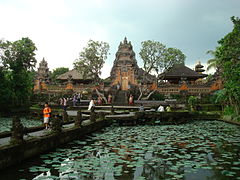
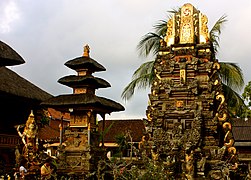
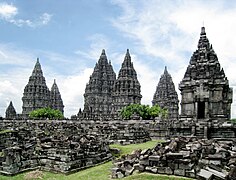
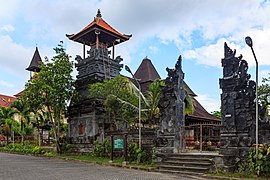
0 Response to "Art Work of the Parisada Hindu Dharma Indonesi or Bali Rubenstein"
Enviar um comentário